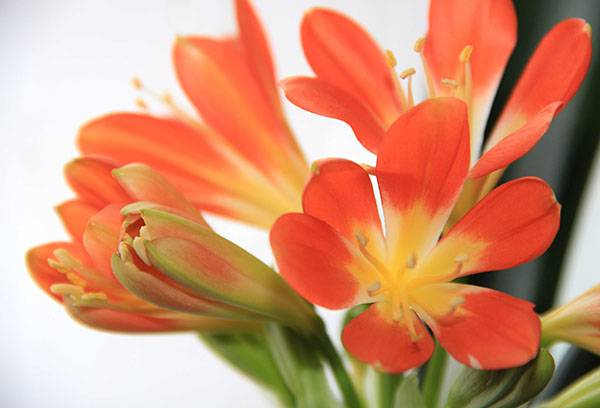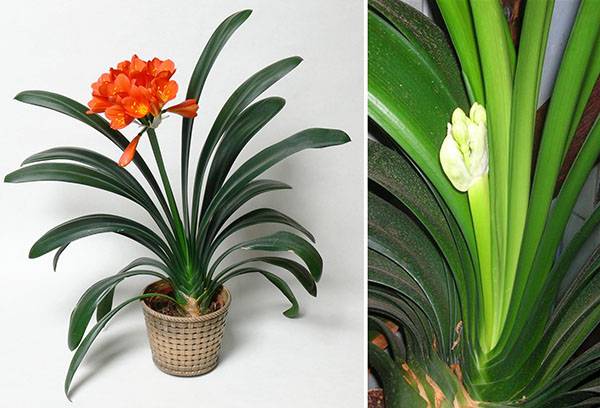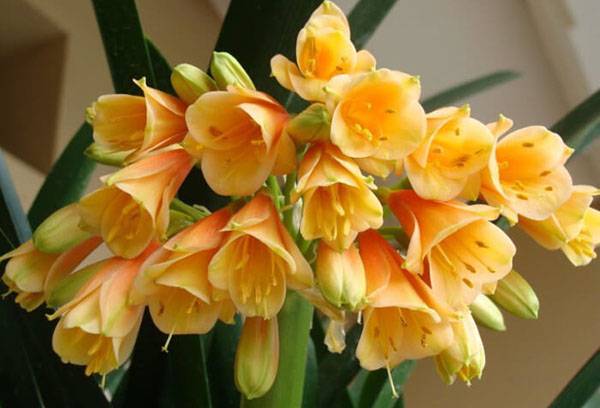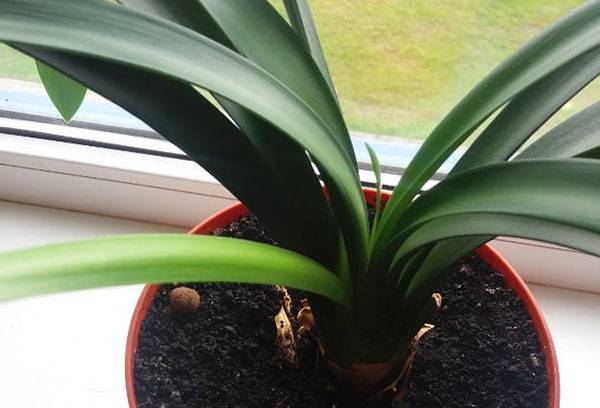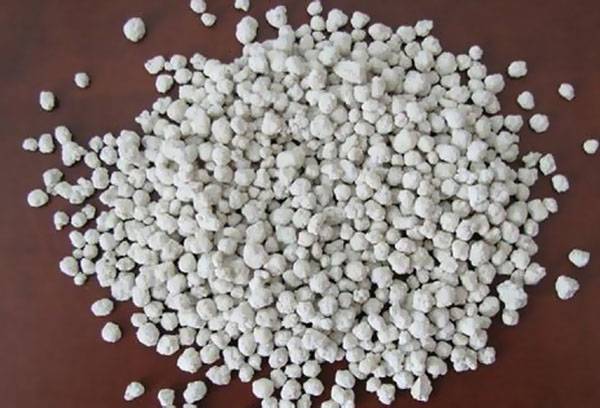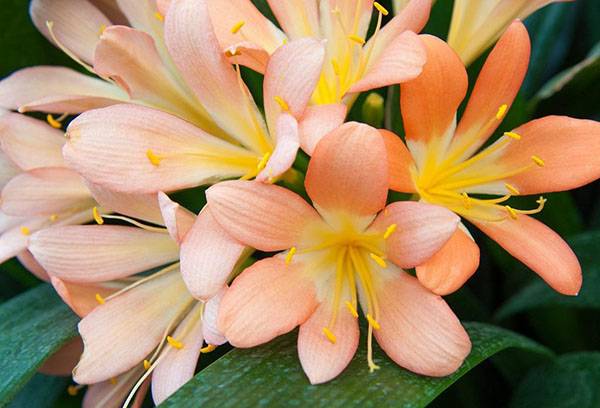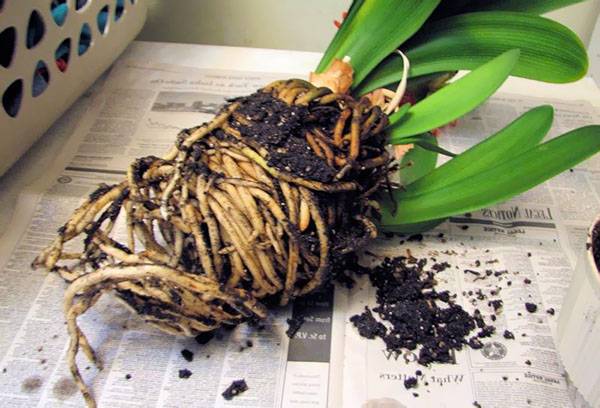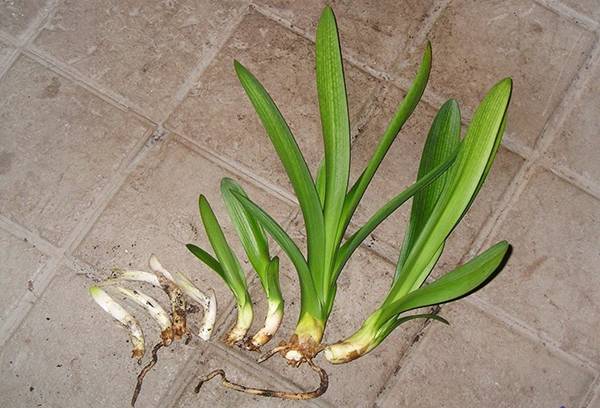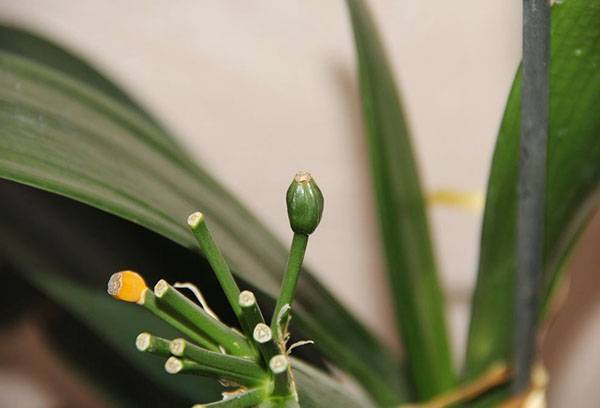Clivia care and breeding at home
Content:
The beauty of clivia is loved by many gardeners, not only for its bright large inflorescences, organically complemented by dark green fleshy leaves, but also for its unpretentiousness. Caring for clivia at home is not difficult. The main thing is to create favorable conditions for the tropical plant - good illumination, normal humidity and a comfortable temperature. In order for clivia to please its incredibly beautiful inflorescences from year to year, it is necessary to provide it with a dormant period in autumn, which usually captures October and November. The culture has many varieties, but civar clivia is grown mainly in apartments.
Plant description
The birthplace of clivia is considered South Africa. In the wild, this perennial evergreen plant, belonging to the amaryllis family, is a bush with huge elongated leaves rising directly from the ground and reaching a height of up to two meters. Indoor flower is not so large in size, although adult plants can grow up to one meter.
Clivia in its structure is very different from other flower crops. She has no bulbs. Its leaves are closely adjacent to each other at the base and, intertwined like pigtails, form a false stem. The root system of the plant is represented by individual processes, to which the bases of the leaves are attached. Thus, we can say that clivia does not apply to bulbous or rhizome cultures.
This houseplant with good care can live more than 40 years and can bloom every year. Usually flowering occurs at the end of February and lasts a whole month. At this time of the year, it is especially joyful to observe how life-affirming orange, dark red or yellow inflorescences framed by lush foliage of dark green blossom. After flowering is over, clivia remains attractive and can easily fit into any interior. Adult plants sometimes throw up to fifty peduncles.
Among the peoples of Africa, clivia is considered one of the most useful plants. In folk medicine, absolutely all parts of the flower are used: rhizome, leaves and peduncles. From clivia, infusions from fever and ointments from bites of poisonous snakes are prepared, painkillers and drugs that stimulate labor. However, you should always remember that the juice of this representative of the tropical flora is very poisonous, therefore it is quite dangerous to self-medicate.
How to care for clivia?
Clivia is unpretentious and does not require any special knowledge and skills. To ensure normal care, it is enough for the grower to create conditions favorable for the growth of this plant, to water it and feed it in time - and it will be possible to admire fancy flowers every winter.
Lighting
For clivia bloom, the illumination of the room plays a very important role. If you place the pot near a window facing north, the plant will be catastrophically lacking light, as a result of which it will grow very slowly, and you can not wait for flowers at all.
It is best to grow clivia in those rooms that are directed east or west, where the flower is provided with bright diffused light. If it is not possible to put the pot where it is convenient, and you have to grow your pet on the southern windows, you need to muffle sunlight with a light curtain.
For the summer, clivia can be taken out to the garden or terrace, while remembering that the flower will feel comfortable only in partial shade.
Temperature
In spring and summer, in the room where clivia is grown, you need to maintain the air temperature from + 20 ° C to + 25 ° C. In autumn, in October and November, the plant needs to provide a dormant period. At this time, it can be placed in an unheated extension or other utility room, where the temperature does not rise above + 14 ° C, but there is always a window.
Temperature is very important for future flowering. Of course, clivia, at rest, will not die when kept in a warmer room, but this can adversely affect its well-being and flowering. Inflorescences will be small, and the flowering period will be short. As soon as the plant begins to throw out new peduncles, the temperature must be increased to + 20 ° C.
Watering
Like many indoor flowers, clivia does not tolerate excessive moisture. It should be watered as the earthen coma withers, and the water that drains into the pan through the drainage hole must be drained. Otherwise, stagnation of water can cause discoloration of the ends of the leaves (they will turn brown), rotting of the roots and death of the flower.
For watering, it is recommended to use soft water without chlorine and other harmful impurities. If water is taken from the city water supply, then it is better to boil or defend it during the day.
When clivia enters the dormant phase, the air temperature in the room is reduced, and watering is almost completely stopped. At this time, once every 10 days it is enough to shed the soil well with water. After the plant throws the first peduncle, you can return to the previous irrigation regime.
Clivia is quite content with air of normal humidity, so it is not necessary to spray it. Sometimes it is enough to wipe the leaves with a damp sponge or bathe the plant under a warm shower.
Top dressing
Clivia loves being fed organic and mineral fertilizers. This helps her to develop and makes inflorescences larger and brighter. The first time a flower is fed in the summer, immediately after planting. Further fertilizers are applied once every 14 days - alternately organic and mineral.
Among organic fertilizers for feeding clivia, preparations based on biohumus are very popular:
- "Ideal";
- "Breadwinner";
- "Giant".
Before fertilizing the soil, they are bred in water. According to the instructions of 1 tbsp. l the drug is dissolved in 2 l of water.
The best mineral fertilizers for clivia are Ammophos and Nitrofoska, which are diluted with water in a proportion of 2 g of powder per 1 liter of water before use.
Clivia can be fed at any time of the year, with the exception of the fall months, when the flower is at rest. As soon as the new arrow of the peduncle appears, fertilization should be resumed.
Important!
Fertilizers with a high nitrogen content can inhibit the appearance of peduncles. Fertilizing with potassium, on the contrary, stimulate the flowering of clivia.
How to make clivia bloom regularly?
Each grower wants to not only grow a green bush, even if it is very decorative and attractive, but also get a flowering plant with bright large inflorescences and high peduncles.
In order for clivia to regularly please with beautiful flowers, it is necessary to remember several rules for growing this plant.
- It is very important that this culture is at rest. Moreover, the duration of the resting phase directly depends on the age of the plant. Young Clivia, whose age is less than five years, will have time to regain her strength in two months - October and November. A more mature plant should rest longer. For clivia older than five years, this period sometimes lasts from September to the end of February.
- During a state of rest, watering is completely stopped, and only if the plant suddenly begins to drop leaves, it can be watered a little.
- As soon as clivia ejects the flower-bearing arrow and it grows 10-15 cm, the pot is transferred to a warm room, they begin to water more often and make fertilizers. The first feeding after dormancy should contain a large amount of potassium.
- The flower does not tolerate anxiety, therefore, during flowering or during the setting of buds, it is extremely undesirable to move the pot from place to place or turn around its axis. Excessive anxiety will cause leaf falling and delayed flowering.
Clivia, grown vegetatively, blooms for the first time in the second year of life. In the case when the plant was propagated by seeds, flowering will begin only in the fourth year.
If all the conditions necessary for growing the plant are met, and the flowers do not appear, then the reason is too spacious. Clivia will bloom only when its root system does not fill the entire pot.
To achieve repeated flowering in the same year, you need to transfer the flower container to a cool, darkened room, stop feeding and reduce watering to once a month. After about 30 days, the plant will release new flower-bearing arrows.
How to transplant clivia?
Caring for clivia is not difficult. It is unpretentious to the conditions of detention, however, it responds very painfully to any intervention in its root system. Therefore, the transplant procedure must be treated with due attention.
The fact that it is time to transplant the flower is indicated by the roots protruding from the pot. Usually young specimens are transplanted once a year, and older ones once every three years and only after flowering. Replanting very old plants is not recommended. It’s better to just update the topsoil in the pot 5-7 cm in depth.
The new pot, in which the flower will grow after transplanting, should be slightly larger in diameter than the old one. Then the rhizome will quickly fill the free space and clivia will bloom faster.
A container for growing a flower must have a drainage hole. When transplanting, claydite, broken brick or small gravel is poured onto the bottom of the pot to ensure that excess moisture is removed from the roots.
The soil used to grow clivia consists of three components: turf, leaf soil and sand, taken in equal proportions. Soil can be bought in the store - you should choose a mixture for orchids, in which clivia feels quite comfortable. If you decide to prepare the soil with your own hands, you should not forget about its disinfection. To get rid of pathogenic bacteria and pest larvae, it is enough to spill the mixture with boiling water or a solution of potassium permanganate, warm in the oven for 10 minutes.
To the prepared mixture add 30 g of phosphorus fertilizer. Superphosphate or phosphate rock will increase soil nutrition.
The clivia transplant is carried out as follows.
- A few hours before the start of work, the flower must be abundantly watered to soak an earthen lump and easily remove the plant from the pot. It is necessary to take out very carefully, trying not to damage the fragile roots. If nevertheless the roots are broken, the damage site should be sprinkled with charcoal. When transplanting a young plant, the rhizome can be washed.
- At the bottom, drainage is poured at 1/4 of the height of the pot.
- Transplant the plant by transshipment. 3-5 cm thick soil is poured into the drainage, an earthen lump is placed in the middle of the pot, the voids are filled with the soil mixture.
Important!
The root neck should rise above the soil level, otherwise the lower leaves will rot.
How to propagate clivia?
Two methods are used for clivia propagation: vegetative and seed. Reproduction by seeds is a long and rather laborious process. It is mainly used by breeders to breed new varieties, although seeds can be obtained at home. The lighter and more often used by gardeners first method is reproduction by parts of the rhizome.
Vegetative propagation
At the next transplant of clivia, the so-called children are separated from the rhizome. Each offspring must have at least four leaves. During this operation, one must remember the fragility of the flower root system and carry out the separation very carefully, being careful not to damage the roots of an adult plant.
The selected processes are planted in cups with a diameter of 5-7 cm, filled with sand or perlite, and put in a cool room (+ 16 ° C). During rooting, the sprouts do not need much moisture, on the contrary, the base of the leaves can rot with an excess of water, so watering should be moderate.
After the “children” take root, they are transplanted into glasses a little more (9 cm). The soil mixture is prepared from sheet, greenhouse land and turf. Two to three years after planting, you can wait for the first buds to appear.
Important!
The roots and leaves of clivia are poisonous, they can not be tasted. It is not recommended to place flowers in rooms where small children can be.
Seed propagation
In order to independently obtain clivia seeds, you need to conduct cross-pollination during the flowering of the plant. If this operation is successful, after a while green ovaries will appear.
The time from pollination to fruit ripening is 9 months. Ripe fruits acquire a red-orange color and become soft to the touch. In each fruit, you can find many seeds, which are used for reproduction at home.
Seeds are planted in a box filled with sand and peat to a depth of 1 cm. After 1.5-2 months, the first seedlings will appear. The resulting plants are planted in separate cups. After a year, young seedlings are transplanted into larger containers.
Clivia propagated by seeds usually blooms only in the fourth year. Therefore, three years after planting, it is necessary to arrange periods of rest for the plant, that is, put it in a cool room and limit watering. According to the reviews of flower growers, in the third year only 30% of plants planted by the seed bloom.
Clivia is an indoor plant of amazing beauty that will harmoniously fit into any interior of an apartment, house or office. The main thing in caring for her is moderate regular watering and the creation of favorable conditions during the dormant period. The reward for proper care and diligence of the grower will be a magnificent bouquet of cheerful flowers that blossomed at the end of winter.
